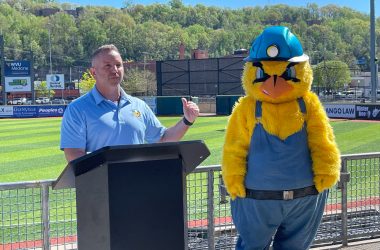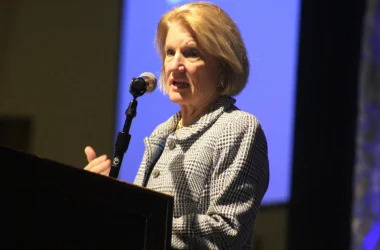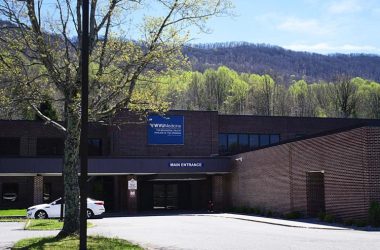WVU Today

(WVU Today photo)
MORGANTOWN, W.Va. – If Shane Lyons has his way, one day soon you are going to drive up Monongahela Boulevard and see a uniform-looking WVU Coliseum complex.
Then, continuing across town to Milan Puskar Stadium, you will see a modernized, attractive Milan Puskar Center to house the Mountaineer football team.
And, just a short 14-minute drive south of town, off the Goshen Road exit of Interstate 79, you will be able to look at a new WVU golf training complex in what was once the White Day Golf Course.
These are the some of the primary elements of Lyons’ new $100 million capital campaign that has been dubbed “Climbing Higher.”
It is ambitious. It is aggressive and it is also unprecedented in its scope and detail during WVU’s long and accomplished athletic history.
“This is a major campaign,” Lyons, beginning his four year as director of athletics, remarked. “We need these improvements for our department and our student-athletes as we continue to grow. You look at the success we’ve had in basketball and soccer, and I think some of that correlates to the improvements made with their facilities from a recruiting and a coaching retention standpoint.”
Of course, he is referring to the beautiful practice facility that has greatly benefitted men’s and women’s basketball, and Dick Dlesk Stadium and Dreamswork Field, which have helped significantly enhance women’s soccer’s national profile.
Those are two programs West Virginians frequently point to as a great source of pride for the state.
Baseball has also experienced a resurgence in enthusiasm and interest while playing in its beautiful new Monongalia County Ballpark.
One day soon, Lyons may be saying something similar about the men’s and women’s swimming and diving teams, which will be moving into their new $45 million aquatic center in 2019, or women’s track, which soon will be performing on its brand new, 1,000-seat, nine-lane outdoor track.
Both are currently under construction out at Mylan Park.
Don’t forget, there are also the recently completed improvements made to the fan experiences at Milan Puskar Stadium and the WVU Coliseum totaling more than $88 million initiated by former director of athletics Oliver Luck and completed by Lyons.
Building off of that, and the momentum from membership in the Big 12 Conference, Lyons felt the time was right to come up with a detailed, comprehensive facility plan that maps out the department’s future for the next three-to-five years.
So, about 18 months ago, soon after the most recent round of Coliseum improvements were completed, he assembled part of his senior leadership team including Deputy Director of Athletics Keli Zinn, Executive Senior Associate Athletic Director Steve Uryasz, Senior Associate Athletic Directors Ben Murray and Simon Dover, Associate Athletic Director April Messerly, Assistant Athletic Director Sam Morrone as well as the athletic department’s maintenance supervisor Bryan Deem and WVU project engineer Bill Linn, and they identified critical facilities that needed to be addressed.
One was the 37-year-old Milan Puskar Center, which houses the Mountaineer football team. Completed in 1981, a year after the construction of Mountaineer Field and formerly known as the Facilities Building, the Puskar Center is in dire need of modernization.
The same goes for the WVU Coliseum, which is rapidly approaching its 50thbirthday. Adjacent to the Coliseum sits the WVU Natatorium and Shell Building, two structures now showing their age. The Natatorium, opened in 1975, and the Shell Building, constructed in 1983, have long been outdated and barely untouched since their completion.
Even Cary Gym, the training center for the WVU gymnastics team, is approaching its 25thyear and is in need of renovating.
In this day and age, 10 years is now considered to be old in the realm of athletic facilities.
“Some of these things are long overdue and it’s a matter of us putting our noses to the grind and trying to make this happen over the next three-to-five years,” Lyons explained. “My philosophy has always been if we don’t have a crane on our complex or something under construction then we’re going backwards. We need to continue moving our department forward, and I feel very positive with where our department is heading.
“The fundraising through our Mountaineer Athletic Club has already started and now we are officially rolling out our ‘Climbing Higher’ campaign to Mountaineer Nation.”
This is what Lyons unveiled today:

Milan Puskar Center Complex – $55 million
The process has already begun on improvements taking place at the Milan Puskar Center. The training room area located adjacent to the team locker room is completed, and highlight’s athletics’ strong partnership with WVU Medicine.
A modernized team training table area is also nearly finished. That project was made possible through WVU’s long-standing relationship with Sodexo.
“Our special thanks to WVU Medicine and to Sodexo. They have been great partners to work with,” Lyons said.
Lyons said the next phase for the Puskar Center includes expansion of the academic center, team locker room, student-athlete lounge, Hall of Traditions, equipment room, coaches’ offices, team meeting rooms and the visiting locker room to increase the facility’s overall square footage to nearly 110,000 square feet, an increase of roughly 22,000 square feet.
“It’s important to note the Puskar Center is a phasing approach so each domino has to fall before the next one begins,” Lyons explained. “You can’t start with one project without phasing onto something else.”
Lyons said plans call for a 5,000-square-foot increase in size to the team locker room, which will include part of the existing visiting team locker room, and constructing a new visiting locker room. Another key aspect of this project is the installation of a modernized ventilation system.
Plans call for the popular Hall of Traditions to be moved to the front of the Puskar Center, similar to the way basketball’s Hall of Traditions is situated at the Basketball Practice Facility, making it accessible to Mountaineer fans visiting the stadium.
The academic center will also be modernized and expanded to more effectively accommodate the 100-plus members of the Mountaineer football team.
The total estimated price tag for these refurbishments is $55 million.
“Through the years, there have been a lot of things we’ve done to the Puskar Center,” Lyons said. “We’ve added the new team room, the training room, the training table and the practice fields, and these are the next areas that sorely need addressed.”

WVU Coliseum Complex – $35 million
The recently completed WVU Coliseum upgrades dealt primarily with the fan experience in the inner concourse of the facility. This round of enhancements includes the replacement of the Coliseum red apron as well as interior improvements, upgraded lighting, a new video board and premium floor-level seating underneath the basket which eventually will also include a media work area.
Behind the Coliseum, Lyons envisions a completely renovated WVU Natatorium, WVU Shell Building and Cary Gym to aesthetically tie into the Coliseum and the Basketball Practice Facility.
Inside the Natatorium, the diving well and swimming pool will be transformed into an Olympic sports weight room and training center, servicing more than 350 student-athletes. The design calls for an open-air, two-level configuration with an aerobic area and student-athlete lounge on the second level where the swimming offices are currently located.
Initially, a new Olympic sports weight room was supposed to be part of the recently completed Coliseum improvement project, but it was delayed when unexpected costs were encountered.
“This gave us an opportunity to go back and reevaluate this,” Lyons admitted.
Outside of the Natatorium, attractive landscaping, a newly designed tiered-walkway and additional lighting will finally transform the entire Coliseum complex into one uniform look of which all Mountaineers will be proud.
Down at the Shell Building, a new indoor track surface, lighting and painting will bring the facility in line with modern competition standards. The back wall near Hawley Field will be replaced and extended to provide additional space for the WVU rowing team to properly store its equipment.
The area where the outdoor track sits will become additional parking for athletic events totaling approximately 500 additional parking spaces, these spaces becoming available with the opening of the aquatics and track complex. Lyons said Hawley Field will remain vacant for now.
“We’ve put needs ahead of wants,” he said. “Whatever would go in the Hawley Field area would be a want at this point.”
Adjacent to the swimming deck where the men’s and women’s swimming and diving teams’ locker rooms are located, Lyons said there will be enough space to construct additional locker rooms.
“The whole front of the Natatorium and Shell Building will change,” Lyons said. “When our swimming and diving teams move out to the new Aquatic Center at Mylan Park in 2019 this will give us an opportunity to turn the Natatorium into our new weight and training center for our Olympic sports athletes.”
The estimated cost for this round of Coliseum complex improvements is $35 million.

Cary Gym – $5 million
Originally constructed in the early 1990s, 12,000-square-foot Cary Gym was a significant improvement from what the WVU gymnastics team once had access to at old Stansbury Hall.
But now more than 20 years later, the time has come to explore new ways to modernize its training area, including adding more training space, a new training room, an upgraded locker room, student-athlete lounge and study area, team meeting room, cardio and rehab area and space for additional storage.
“Improvements will add a new front entrance to Cary Gym which will match a lot of the things we’re planning to do on the other side of the complex,” Lyons explained.
The estimated cost is $5 million.
WVU Golf Complex
When golf was reintroduced as an intercollegiate sport at WVU in 2015, it was done so without a facility to call its own. Since then, several alternatives have been explored and the best solution Lyons’ group came up with was to enter into a least-to-purchase agreement with White Day Golf Course, located just south of Morgantown about a 14-minute drive from campus.

Golf competes in the No. 1 conference in the country and a training facility is sorely needed for Sean Covich‘s infant program to compete.
“If you look at the last three years, the national champion has come from the Big 12 so what Coach Covich is dealing with from a recruiting disadvantage is substantial,” Lyons noted. “We’ve looked at a lot of other facilities and we determined the best option for the department is a lease-to-purchase of the White Day golf course.”
The proposed WVU Golf Complex includes a team clubhouse and locker room, six indoor hitting bays, driving range, short-game area, putting green and a modified six-hole course providing the team with 27 different hole configurations.
“It’s an easy drive to get there, and the land that we will purchase is about 94 acres,” Lyons said. “We will be using all of the land for that complex.”
The estimated cost of the new golf facility is $5 million.
Lyons stresses the dollar figures listed for these four major projects are conservative and factor in inflation and other external factors.
He also emphasizes that these improvements will impact the entire athletic department, not just the specific sports they represent. For instance, the proposed Olympic sports weight room and athletic training area will be the primary training facility for 14 of WVU’s 18 intercollegiate teams.
It is important to understand that this round of improvements primarily addresses the student-athlete experience at West Virginia University.
All projects being considered are subject to WVU Board of Governor’s approval.
“There has been a significant amount of time and effort that has gone into this,” Lyons said. “We looked at many, many different alternatives and we have determined that what we are presenting today is the most viable facility solution for the athletic department.
“This is not an arm’s race – these are sorely needed projects,” Lyons added. “We are not doing anything extravagant or exorbitant. Our plan is to fundraise very, very aggressively and as we near our goals we will look at our budget to see what we can fit in.
“We need to take what we have and make it better.”
Lyons concluded, “I think this is an exciting time. We’ve done a lot of great things over the last three-to-five years with our facilities and this is our next phase. We need everyone to be in on this working together to make it happen.
“And I’m confident Mountaineer Nation will come together, as they have done so many times before, and once again help us make it happen.”
Click HERE for a detailed look at the Climbing Higher campaign with interactive videos, graphics and renderings.
See more from WVU Today




